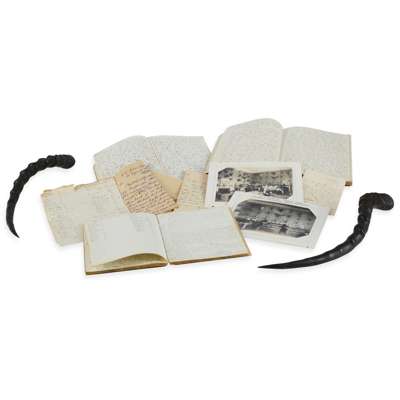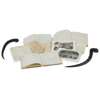
Lot 83

India - Thailand - Malaysia - Zanzibar - Kenya
Manuscript hunting journals of Henry C. V. Hunter, 1885-1887


Auction: 18 June 2025 from 10:00 BST
Description
3 volumes, 4to (22.8 x 17.5cm and 25 x 20cm), approximately 350 pp. in total, limp blue-green skiver bindings with gilt rules to spines and covers, comb-marbled endpapers and edges, signed and dated on endpapers, each journal comprising daily entries and concluding summaries of ‘bags’, evidently written on the spot or in some cases soon after (a few sections with faint ink evidently overwritten at a later date by the author), volume 2 binding with loss to spine, volume binding rear inner hinge gone and with loss to spine. Journals comprise:
1) India, February-November 1885. Approx. 130 pp., with 7 pp. notes at rear (including accounts for camel rental, shikari wages), describing at least 7 distinct expeditions, including: river expedition around Dholpur, Rajputana Agency (modern Rajasthan), including pig-sticking and fowling, visits to Jehanpur, Beelpur, Bari, etc., party members including ‘H. H. Rana’, possibly Nihal Singh (1863-1901), Maharaj-Rana of Dholpur (r.1873-1901), and his Dewan Sahib; expedition in Rewa district (modern Madhya Pradesh), tiger hunting, visits to Govindgarh, Ramnagar, Sarsi, Manpur, Marwhas (3rd May: ‘No news of tiger here so pushed on to Marwhas which place boasted a Raja and tehsildar whose acquaintance we made … The Raja was a fine tall man and seemed willing to do his best to help us with Shikar’); September-October, expedition to Kashmir (Srinagar, Sumbal, Shadipur, etc.); expedition from Srinagar to the Salt Range mountains (including a pencil sketch of a goat); pig-sticking expedition with the Rana and Rao of Sri Muttra; and similar.
2) Thailand, Malaysia, Singapore. November 1885-June 1886. Approx. 70 pp., with some 10 documents laid in. November: leaves Calcutta for Bangkok, landfalls in Rangoon, Penang, Singapore. December: 7 days in Bangkok, meets ‘Prince Dewan’, king’s half-brother and ‘right hand man’, who advises travel along Mekong River to Kanburi (Kanchanaburi). December-January: hunting around Kanburi, bag includes leopard, Burmese deer, barking deer, flying squirrel, peafowl, etc., constructs howdah for shooting from elephant-back, encounters Karen village (‘The Karen are not allowed guns but they used a crossbow with poisoned arrows, very small and made out of bamboo’) and other locals, describes stalking tactics, animal behaviour, etc. February: hunting around Korat. March: travels via Singapore to Johor for unsuccessful hunting trip (‘shot at nothing but 1 green pigeon’). March-May: hunting in Selangor, visits to Kuala Lumpur, Ulu Klang, Ulu Langat, Beranang River, often with Rajah Mas, ‘headman’ of Ulu Klang district, returns Singapore 31st May, Selangor bag includes bison, sambhar, crocodile, civet, etc. Thai glossary (2 pp.) at end.
3) Zanzibar and Kenya, November 1886-June 1887. Approx. 126 pp., with 16 pp. notes at rear (accounts and a Swahili glossary). Leaves London on 5th November, landfalls in Aden and Lamu, in Zanzibar 28th November-6th December, obtains interview with Sultan of Zanzibar (Barghash bin Said) at palace: ‘We saw the regular troops drawn up in line with General Matthews at their head’; 50 courtiers and family members in attendance; Captain John C. Willougbhy (see below) presents sultan with letter from Prince of Wales. December-April: expedition from Mombasa via Maungu, Ndara and Taveta to Kilimanjaro with caravan of 250 men, describing meetings with local peoples and leaders including Waduruma people and chief Bogole (‘Mbugoli’ in Willoughby’s account), tribal conflict, a violent encounter with an Arab slave-trader, etc. April-June: further hunting in environs of Taveta. Bag includes elephant (3), rhinoceros (24), giraffe (3), warthog (8), alligator (2), zebra (4), lioness (1), and more
Provenance
By descent to the vendor.
Footnote
Henry Charles Vicars Hunter (1864-1931), big-game hunter and naturalist, was the only son of Henry Fotheringham Hunter of Kilbourne Hall, Derbyshire, and was educated at Charterhouse and Christ Church, Oxford. His expedition to Mount Kilimanjaro, the subject of the third journal, is also described in a published account by fellow expedition member Captain John C. Willoughby, East Africa and its Big Game: The Narrative of a Sporting Trip from Zanzibar to the Borders of the Masai (1889). In 1888, still in Kenya, Hunter discovered the hirola, or Hunter's hartebeest (Beatragus hunteri): a specimen pair of hirola horns obtained by Hunter is included with the lot (approx. length of each horn 45cm), together with two original photographs (gelatin silver prints, 15 x 20cm) showing the trophy room at Abermarlais Park, Llangadog, Carmarthenshire, where Hunter lived later in life. Hunter is 'also remembered in the names of two birds, Hunter’s Sunbird Nectarinia hunteri and Hunter's Cisticola Cisticola hunteri. The hirola [Hunter's hartebeest] is found in southern Somalia and northern Kenya. It is now a rare and seriously endangered species' (Beolens et al., The Eponym Dictionary of Mammals, 2009, p. 201). Hunter's two sons, Henry John Francis (1893-1966) and Thomas Vicars (1897-1917) both served with distinction as Royal Flying Corps fighter pilots during the First World War, Thomas being killed in action while Henry survived and proceeded to senior rank in the RAF.
Beatragus hunteri is currently not stated on CITES Appendix I, II or III: both horns in the lot were collected before 3rd March 1947.

